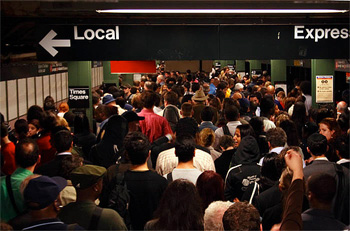Last week’s news that NYC Transit is planning to boost L train service isn’t just good for residents of Williamsburg. It points to a new era of faster and more reliable service throughout the subway system as the new signal technology known as Communications Based Train Control (CBTC) begins to take hold.

As the Times and Second Avenue Sagas reported, L train riders will start benefiting from more frequent service next summer, when the MTA adds trains on the weekends, which have seen an 84 percent jump in ridership since 2005. But the major advance in service, which promises to relieve crowding on some of the most jam-packed rush-hour trains in the system, will come at the end of 2012, when the new CBTC signaling system is slated to be completed.
Like most transit improvements here, the implementation will be slow and will come with some service disruptions. But the short-term pains will be well worth this major upgrade to NYCT's antiquated signal technology. Whereas the century-old system now in use relies on block signals with colored lights alongside the track to tell operators if they’re too close to the train ahead, CBTC uses radio signals to locate all of the trains on the line. With this information, on-board computers can calculate the distance between trains precisely and in real time, letting operators run trains closer together without compromising safety.
With more trains per hour, wait times will diminish and trains should be less crowded — allowing for increased ridership as the experience of riding the subway becomes more convenient and pleasant. Adding just one train per hour adds space to move another 2,640 people. That translates to fewer times waiting while a packed train goes by, and fewer elbows in your ear when you board.
Unlike service changes that can be put in place virtually overnight, CBTC requires years of investment via the MTA’s capital program. The new signaling system on the L is the product of substantial investment starting in the mid-1990s and continuing today. Along with investments in new subway cars and buses, station repairs and upgrades (including elevators), and track replacements, CBTC is one of the “workhorse” projects that together require far more MTA capital expenditures than megaprojects such as East Side Access and the Second Avenue Subway. And rightly so -- CBTC is destined to improve the speed and comfort of rides all over the city.
The L train improvements, in fact, don't fully convey what CBTC can accomplish. The line doesn’t have the “tail tracks” (extra space for turning trains around) at Eighth Avenue that would be needed to allow double-digit percent increases in train throughput.
The next two CBTC installations do have room, and these shouldn’t be made to wait any longer for the extra capacity CBTC will allow. Riders on the 7 train desperately need the added service, especially now that the Flushing Main Street station is the city’s tenth busiest with 18.6 million rides last year. The current five-year capital program includes funds to fully equip 7 train tracks and cars for CBTC. The MTA has also targeted the Queens Boulevard lines (E, F, M, and R trains) for CBTC installation — a process starting in 2013 and intended for completion during the next capital program, which is supposed to begin in 2015. Some stations on this line are among the system’s most crowded, with over 6 million rides per year. Jamaica Center teems with over 11 million. The MTA can complete these improvements, provided it gets financial support from the governor and the legislature and escapes the budget raids that Albany has imposed with alarming regularity lately.
Although the seeds for implementing CBTC and improved service on the L train were planted almost two decades ago, the project wouldn’t be coming to fruition without the watchdog efforts of legislators like Sen. Daniel Squadron, who has made transit provision a priority and called on the MTA in July to address weekend overcrowding on the L train. The MTA’s thoughtful response to Sen. Squadron, which highlights CBTC, could mean that the authority is turning a corner in responding to riders’ needs. Perhaps the impact of this project will help other elected officials and the public at large to grasp their interest in supporting the capital program with a sustainable funding stream — one that lets innovations like CBTC take the pressure off jammed subway lines.





